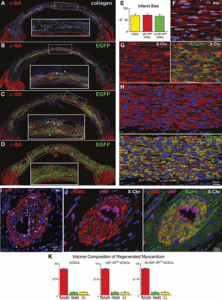 A group of Harvard stem cell researchers who already have one retraction and an expression of concern now have a correction. This one’s in Circulation Research, and it involves an image that previously had been flagged as suspicious in our comments.
A group of Harvard stem cell researchers who already have one retraction and an expression of concern now have a correction. This one’s in Circulation Research, and it involves an image that previously had been flagged as suspicious in our comments.
The group is led by Piero Anversa, who as we reported last year is one of two researchers suing Harvard because the institution’s investigation into their work
has cost them millions in a forfeited sale of their company, and job offers.
As Boston news outlets reported at the time, Anversa and his colleague, Annarosa Leri, claim their
professional reputations and careers have been shattered by an inquiry and investigation process that has been conducted contrary to federal regulation and institutional policies, and has been publicly disclosed by Defendants.
Leri and Anversa are co-authors of the Circulation Research article, titled “Insulin-Like Growth Factor-1 Receptor Identifies a Pool of Human Cardiac Stem Cells With Superior Therapeutic Potential for Myocardial Regeneration.” Here’s the notice:
In the Circulation Research article by D’Amario et al (Insulin-Like Growth Factor-1 Receptor Identifies a Pool of Human Cardiac Stem Cells With Superior Therapeutic Potential for Myocardial Regeneration. Circ Res. 2011;108:1467–1481. DOI: 10.1161/CIRCRESAHA.111.240648), a correction was needed.
During the course of an ongoing investigation, questions were raised about Figure 7I in the article, which may not adequately reproduce the originally acquired image. Accordingly, the authors have generated a new figure using data from the same sample. The new figure demonstrates the same findings as the original figure, and it does not change the conclusions of the published article.
Figure 7I.This panel illustrates the localization of Alu DNA sequences in the nuclei of a resistance arteriole.
The authors regret this circumstance. This correction been noted and updated in the online version of the article, which is available at http://circres.ahajournals.org/content/108/12/1467.full.
The paper has been cited 43 times, according to Thomson Scientific’s Web of Knowledge. Its last author, Jan Kajstura, was blamed in the lawsuit by Anversa Leri for the problems in two other papers.

So, if your figure is discovered as manipulated, you can offer a different one, and the matter is settled, no questions asked? But how do we know that new image (or any other image in the paper, for that matter) shows what it is supposed to show? I know science works on trust, but still, in such case…
If paragraph 157 in the Anversa-Leri lawsuit is correct,
“157. Drs. Anversa and Leri had a multimillion dollar offer to purchase their company, Autologous/Progenital, which was withdrawn when the investigation was publicly disclosed.”
then why is there no financial conflict disclosure by Dr. Leri in this Circulation paper?
This concern applies to essentially all of their publications and disclosing their financial conflict of interest seems to me to be a massive tactical error made by the attorney that prepared the lawsuit filing.
“Figure 7I in the article, which may not adequately reproduce the originally acquired image.”
————-
“May not”. The authors do not know whether the figure in question was correct or not? How is that possible?
They had no choice, and in addition, it was the ethical thing to do. The lawsuit concerned the failed sale of this very company.
The point I was trying to make is that all of the journals they are publishing in also have conflict of interest disclosure policies but I can’t find any mention of their company in any of the papers. They can’t have it both ways by failing to disclose the company when they publish but then claiming that they have been harmed when the company is devalued because of the misconduct investigation. And in the filing they claim that Nabel and co have a “conflict of interest” because they are also associated with companies that are working on therapies for MI. But of course by the same token they are also arguing that someone who stands to gain financially might also have a motive for making up or misrepresenting their own data. Its just dumb.
The conflict is there, whether acknowledged or not, for all these groups that try to mix maximizing profit with publishing sexy results in top journals and clinical trials on patients. This is just playing with fire.
“Accordingly, the authors have generated a new figure using data from the same sample.”
hmm… if the correct data could have been generated from the “same sample” then why was there a need for image manipulation in the first place?
This is all very strange…..
“involves an image that previously had been flagged as suspicious in our comments.”
Is that correct? Looking back at the comments, Figs 1-4 were flagged but, as far as I can see, Fig. 7 was not. So Fig. 7’s involvement would be in addition to the figure flagging of this fascinating paper that went on at RW.
Might it actually be possible that the Fig. 7 issue was spotted earlier? Perhaps it was a discovery made internally during the investigation that is presumably still ongoing?
Roberto Bolli, editor of Circulation Research and longtime collaborator of Anversa’s (PubMed shows 21 jointly authored papers), chooses to issues a “CORRECTION” rather than a retraction.
The answer is simple: “The new figure demonstrates the same findings as the original figure, and it does not change the conclusions of the published article.” Why retract a perfectly good article?